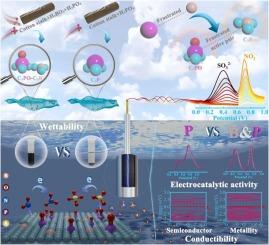Dual-role boron and oxidized phosphorus in collectively constructing the signal-amplified bio-carbon electroanalysis platforms for simultaneous recognition of sulfite and nitrite in aquaculture
IF 3.7
1区 化学
Q1 CHEMISTRY, ANALYTICAL
引用次数: 0
Abstract
Developing the signal-amplified yet low-cost electrochemical analysis platforms for determination of sulfite and nitrite in aquaculture water is still a challenging but significant task. Herein, an attractive boron and phosphorus co-modified bio-carbon (BP-bioC) sensitive material synthesized via ultrasonic impregnation with cotton stalk and boric acid/phosphorus acid and followed pyrolysis is reported for simultaneously discriminating sulfite and nitrite through differential-pulse-mode voltammetric signals. The physico-chemical characterizations and electrochemical characterizations suggest that under optimized mass ratio of H3BO3/H3PO4 (0.2), the resultant BP-0.2-bioC possesses the faster electron-transfer kinetics and lower impedance as compared to the pristine phosphorus-modified bio-carbon (P-bioC), which is profited from the critically metallic-role boron (C3B). Also, the higher electrocatalytic activity is observed thanks to non-metallic role of boron (C2BO/CBO2) which promotes more electroactive oxidized phosphorus (C3P = O) configurations by phosphorus-boron Frustrated Lewis Pairs, in turn generating the unique phosphorus-frustrated-boron active site pairs (C3B-C3P = O). More strikingly, the evolution of wettability in the presence of boron ensures the availability of electroactive site pairs during electrochemical sensing process. These combined advantages impart the electrochemical sensing platforms (BP-0.2-bioC/ESPs) the enhanced electroanalytical properties towards sulfite and nitrite with limit of detection (LOD) low to 34.71 μM and 2.10 μM, respectively, which enable to compare favorably with certain metal-based sensing platforms reported. DFT calculations conclude that the combined active pairs of C3P = O and C3B show the best electrocatalytic activity towards sulfite and nitrite, respectively. This contribution provides guidance for deliberately devising ultrasensitive bio-carbon based electroanalysis platforms concerned sulfite and nitrite in aquaculture waterbodies or related aquacultural products.

双作用硼和氧化磷共同构建水产养殖亚硫酸盐和亚硝酸盐同时识别的信号放大生物碳电分析平台
开发低成本的信号放大电化学分析平台用于水产养殖水中亚硫酸盐和亚硝酸盐的测定仍然是一项具有挑战性但意义重大的任务。本文报道了一种具有吸引力的硼磷共改性生物碳(BP-bioC)敏感材料,该材料以棉花秸秆和硼酸/磷酸为原料,经超声浸渍后进行热解,可通过差脉冲模式伏安信号同时识别亚硫酸盐和亚硝酸盐。物理化学表征和电化学表征表明,在优化的H3BO3/H3PO4质量比(0.2)下,BP-0.2-bioC具有更快的电子传递动力学和更低的阻抗,而原始的磷修饰生物碳(P-bioC)得益于临界金属作用硼(C3B)。此外,由于硼(C2BO/CBO2)的非金属作用,更高的电催化活性被观察到,它促进了磷-硼受挫刘易斯对更具电活性的氧化磷(C3P=O)构型,从而产生独特的磷-受挫硼活性位点对(C3B-C3P=O)。更引人注目的是,在硼的存在下,润湿性的演变确保了电化学传感过程中电活性位点对的可用性。这些优点使BP-0.2-bioC/ESPs电化学传感平台对亚硫酸盐和亚硝酸盐具有更强的电分析性能,检测限(LOD)分别低至34.71 μM和2.10 μM,与某些金属基传感平台相比具有优势。DFT计算表明,C3P=O和C3B组合对亚硫酸盐和亚硝酸盐的电催化活性最好。这一贡献为有意设计有关水产养殖水体或相关水产养殖产品中亚硫酸盐和亚硝酸盐的超灵敏生物碳基电分析平台提供了指导。
本文章由计算机程序翻译,如有差异,请以英文原文为准。
求助全文
约1分钟内获得全文
求助全文
来源期刊

Sensors and Actuators B: Chemical
工程技术-电化学
CiteScore
14.60
自引率
11.90%
发文量
1776
审稿时长
3.2 months
期刊介绍:
Sensors & Actuators, B: Chemical is an international journal focused on the research and development of chemical transducers. It covers chemical sensors and biosensors, chemical actuators, and analytical microsystems. The journal is interdisciplinary, aiming to publish original works showcasing substantial advancements beyond the current state of the art in these fields, with practical applicability to solving meaningful analytical problems. Review articles are accepted by invitation from an Editor of the journal.
 求助内容:
求助内容: 应助结果提醒方式:
应助结果提醒方式:


